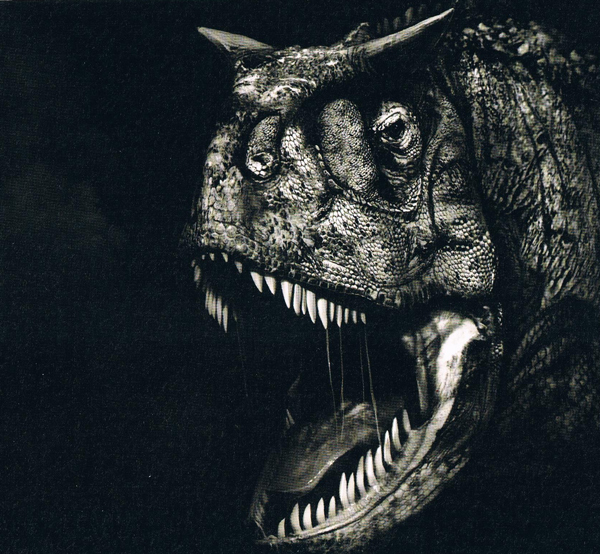A Ferocious Carnotaurus
The image below is an illustration of the Late Cretaceous South American abelisaurid Carnotaurus (C. sastrei), by the renowned Chinese palaeoartist Zhao Chuang. This is one of our favourite illustrations of the dinosaur known as “meat-eating bull”.
The Illustration of Carnotaurus (C. sastrei)
Picture credit: Zhao Chuang
The artwork (above), was produced as part of a series of commissioned pieces to illustrate the science/art world by Zhao Chuang and Yang Yang for PNSO (Peking Natural Science-Art Organisation).
Carnotaurus sastrei
Known from an almost complete skeleton found in Argentina, this large, carnivorous dinosaur was scientifically described in 1985. Zhao Chuang has chosen to focus on the remarkable skull of this Late Cretaceous abelisaurid. The head is short and blunt with two imposing horns positioned over the eye sockets sticking out sideways. The deep skull contrasts with the slender lower jaw which for such a large dinosaur (estimated at more than seven metres in length), indicates a relatively weak bite.
Everything Dinosaur stocks a wide selection of Carnotaurus models.
To view these models: Dinosaur and Prehistoric Animal Models.
For many years, Carnotaurus was regarded as a hunter of large prey, however, analysis of the bite force exerted by the jaws indicated a surprisingly weak bite for a carnivore weighing in excess of a tonne. Research (Mazzeta et al 2009), indicated that this dinosaur could generate a bilateral bite force – measured on both sides of the jaw, of around 3,400 Newtons. In contrast, the much smaller extant lion (Panthera leo) and the spotted hyena (Crocuta crocuta) are capable of generating bite forces of at least 1.3 times the bite force calculated for Carnotaurus, even though these living carnivores are considerably smaller.
As to what Carnotaurus ate, this is open to speculation, but it could have specialised in catching smaller animals or perhaps it was a specialised scavenger, the narrow jaws proving adept at removing flesh from corpses. Whatever, Carnotaurus consumed, we still take time out to admire this marvellous illustration by the very talented Zhao Chuang.
The Everything Dinosaur website: Everything Dinosaur.







How would they get an estimate of the bite force? I’m not doubting the facts displayed here I just want to learn how they estimate it.
The research paper cited in the article is entitled “Cranial Mechanics and Functional Interpretation of the Horned Carnivorous Dinosaur Carnotaurus sastrei” by Gerardo V. Mazzetta, Adrián P. Cisilino, R. Ernesto Blanco and Néstor Calvo which was published in the September 2009 edition of the Journal of Vertebrate Paleontology. To calculate the potential bite forces of C. sastrei the team produced a life-size resin cast of the skull and jaws of a Carnotaurus specimen, the holotype (MACN-CH 894). Computerised tomography (CT) scans of the actual fossils were taken and from this data the cast could be constructed using 3-D printing techniques.
Three-dimensional finite element analysis was then undertaken on this resin cast to assess the mechanical performance and projected stress levels that occurred during simulated biting and other jaw movements. To test the validity of their mathematical model, it is common practice for researchers to compare their projected bite forces for an extinct animal with bite forces estimated using the same processes for extant (living) animals. Conventional bite force tests using force meters to record the actual bite pressure of the living animal can then be undertaken so that a direct comparison between the calculated bite force and the actual bite force recorded can be made. If the calculated bite force measurements using the mathematical model are close to the actual bite force measurements observed, then the research team can express confidence that the mathematical model used to calculate the bite force and skull stresses of Carnotaurus sastrei had produced reasonably accurate results.